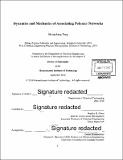Dynamics and mechanics of associating polymer networks
Author(s)
Tang, Shengchang, Ph. D. Massachusetts Institute of Technology
DownloadFull printable version (41.94Mb)
Other Contributors
Massachusetts Institute of Technology. Department of Chemical Engineering.
Advisor
Bradley D. Olsen.
Terms of use
Metadata
Show full item recordAbstract
Associating polymers have attracted much interest in a variety of applications such as selfhealing materials, biomaterials, rheological modifiers, and actuators. The interplay of polymer topology and sticker chemistry presents significant challenges in understanding the physics of associating polymers across a wide range of time and length scales. This thesis aims to provide new insights into the structure-dynamics-mechanics relationships of associating polymer networks. This thesis first examines diffusion of various types of associating polymers in the gel state through a combination of experiment and theory. By using forced Rayleigh scattering (FRS), phenomenological super-diffusion is revealed as a general feature in associating networks. Experimental findings are quantitatively explained by a simple two-state model that accounts for the interplay of chain diffusion and the dynamic association-dissociation equilibrium of polymer chains with surrounding network. Furthermore, hindered self-diffusion is shown to directly correlate with a deviation from the Maxwellian behavior in materials rheological response on the long time scale. To further understand how sticker dynamics affects the network mechanical properties, a new method referred to as "sticker diffusion and dissociation spectrometry" is developed to quantify the dissociation rate of stickers in the network junctions. It is demonstrated that sticker dissociation is a prerequisite step for sticker exchange that leads to macroscopic stress relaxation. Finally, this thesis explores the use of fluorescence recovery after photobleaching (FRAP) to measure self-diffusion of associating polymers, and a mathematical framework is established. The second part of this thesis focuses on the development of new methods of controlling the mechanical properties of associating networks through engineering the molecular structure of polymer chains. Specifically, topological entanglement is introduced into the network through extending the polymer chains to reach beyond their entanglement threshold. This strategy drastically enhances material's toughness, extensibility, creep resistance and stability in solutions. Various types of coupling chemistries are then explored to fine tune the extent of entanglement. The entanglement effect and the long-time relaxation of materials can be further controlled by introducing branching points into the macromolecules.
Description
Thesis: Ph. D., Massachusetts Institute of Technology, Department of Chemical Engineering, 2016. Cataloged from PDF version of thesis. Includes bibliographical references.
Date issued
2016Department
Massachusetts Institute of Technology. Department of Chemical EngineeringPublisher
Massachusetts Institute of Technology
Keywords
Chemical Engineering.